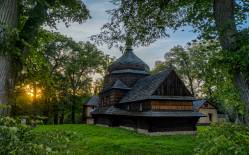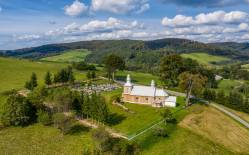This beautiful wooden church was once a Greek Catholic parish tserkva of the Transfiguration of Our Lord. It was built in 1742 following efforts of a local priest, Jan Pacławski. However, it can justifiably be speculated that the building was thoroughly reconstructed and altered that year, but the original structure is far older. It is possible that above the pritvor there was a chapel, important in Orthodox Christianity, but unnecessary in Uniate Church after the Synod of Zamość held in 1720. During the following centuries repairs and alterations were conducted in the building many times. After the post-war relocations, in 1967 it was suggested the tserkva become a branch of the Museum of Folk Architecture in Sanok, but the concept was not accepted by the local residents. During Christmas, Roman Catholic inhabitants of the village broke into the tserkva to hold a holy ceremony. Ultimately, Roman Catholic services were held here until 1995. This is when a new brick church was built in the village, and the tserkva was no longer needed. It was then reacquired by the local Greek Catholic community and today it is a branch of the Sanok parish.
The log church, oriented towards the east, comprises three parts. Added as an extension to the chancel, the sacristy was built after 1836. The nave is wider, and on the western side there is a narrower narthex. Outside, the body of the tserkva is circumscribed by a skirt roof supported on rafter tails. Gable roofs are covered with shingles; above the nave there is a Baroque octagonal onion dome, also covered with shingles, and topped with an octagonal turret. Nearby there is a small house formerly used for purposes of religious education. In front of the church there is a belfry built in 1887. Its post and beam structure comprises two stories.
On the walls along the nave, we can see a wall paintings depicting Saint Olga of Kiev, and St. Vladimir the Great. The latter painting is damaged, because a part of the figure was removed along with an old beam. Fragments of an older iconostasis are in the holdings of the Museum of Folk Architecture in Sanok. The tserkva retains two post-synodal side altars with 19th century icons. These were discovered by accident, underneath twentieth century icons mounted on top. Inside we can also see a painting of the Holy Trinity, from 1877. The entrance doors from the 1700s feature a unique wooden lock and the original key.
The cemetery next to the tserkva hold graves of grandparents of Bohdan Ihor Antonych, one of the greatest Ukrainian poets of the 20th century.
The tserkva is administered by the Foundation of Metropolitan Archbishop Andrey Sheptytsky. Liturgical services are held here occasionally.
Photo: Krystian Kłysewicz
Gallery

Recommended venues on the Trail



This website has been modernized with the financial support of the European Union under the Cross-Border Cooperation Programme Poland-Belarus-Ukraine 2014-2020. The responsibility for its content lies solely with the Podkarpackie Regional Tourism Board and cannot, in any case, be treated as a reflection of the position of the European Union, the Managing Authority, or the Joint Technical Secretariat of the Cross-Border Cooperation Programme Poland-Belarus-Ukraine 2014-2020.













